Time is ripe for sightings of lesser spotted woodpecker


It is only the size of a sparrow and spends much of its time high in the tangled branches at the top of trees searching for insects making it extremely hard to see.
But from now on the males become very audible, drumming with their beaks on dead branches and also producing a sharp pee pee pee call, not unlike that of a nuthatch.
Advertisement
Hide AdAdvertisement
Hide AdThe lesser’s larger cousin the great spotted woodpecker is also drumming now to establish territory but by listening carefully it is possible to tell the two apart.
The great spotted’s drumming is loud but only goes on for about a second while the lesser’s drumming is thinner, more high pitched and each burst goes on for longer – the sound has been compared with the noise of a creaking branch.
But following the sounds is the probably the most reliable way, with luck, of finding a lesser spotted woodpecker.
The lesser and great spotted are both black and white but the great really does have bold patches of black and white on its back while the lesser has conspicuous black and white bars up its back instead – a better name for it would be the ladder-backed but this has already been taken by a North American woodpecker.
Advertisement
Hide AdAdvertisement
Hide AdGreat spotted woodpeckers also have a blood red splash under the tail which lessers lack while male lesser have a crimson red crown and the females a dull white crown.
Their favourite habitat is in open woodland, often containing oak trees with decaying branches in which they can excavate nest holes and search for food. They are also found in stands of alder or in orchards.
Lesser spotted woodpeckers are in serious decline and have disappeared from many woodlands.
There is continuing research as to why this is happening with low nest productivity the most likely cause discovered so far. Lesser spotteds nest on average a week to ten days later than the greats, which are thriving, and this might affect productivity.
Advertisement
Hide AdAdvertisement
Hide AdFortunately, there are still some places in our region where they might still be found – there have been several sightings on the Potteric Carr reserve, South Yorkshire over the past few days.
Spring migrants started to be seen in the region this week with the first sand martins at many sites, singing chiffchaffs, and a midweek arrival of wheatears further south.
A sandwich tern, the earliest record for South Yorkshire by ten days, was seen over Broomhill Flash and later Pugney’s Country Park near Wakefield.
The yellow-browed warbler and firecrest continued to be seen at Wombwell Ings while another firecrest reappeared in riverside trees at Methley Copse on the St Aidan’s site, Leeds and one was reported in a garden at Nether Edge, Sheffield.